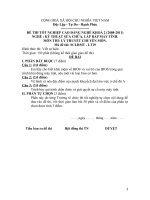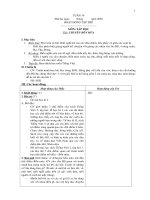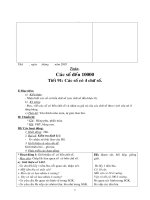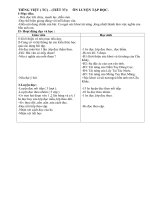PASSAGE 19
Bạn đang xem bản rút gọn của tài liệu. Xem và tải ngay bản đầy đủ của tài liệu tại đây (39.56 KB, 3 trang )
PASSAGE 19
Basic to any understanding of Canada in the 20 years after the Second World War is the country’s
impressive population growth. For every three Canadians in 1945, there were over five in 1966. In
September 1966 Canada’s population passed the 20 million mark. Most of this surging growth came from
natural increase. The depression of the 1930s and the war had held back marriages, and the catching-up
process began after 1945. The baby boom continued through the decade of the 1950s, producing a
population increase of nearly fifteen percent in the five years from 1951 to 1956. This rate of increase had
been exceeded only once before in Canada’s history, in the decade before 1911, when the prairies were
being settled. Undoubtedly, the good economic conditions of the 1950s supported a growth in the
population, but the expansion also derived from a trend toward earlier marriages and an increase in the
average size of families. In 1957 the Canadian birth rate stood at 28 per thousand, one of the highest in
the world.
After the peak year of 1957, the birth rate in Canada began to decline. It continued falling until in 1966
it stood at the lowest level in 25 years. Partly this decline reflected the low level of births during the
depression and the war, but it was also caused by changes in Canadian society. Young people were staying
at school longer; more women were working; young married couples were buying automobiles or houses
before starting families; rising living standards were cutting down the size of families. It appeared that
Canada was once more falling in step with the trend toward smaller families that had occurred all through
the Western world since the time of the Industrial Revolution.
Although the growth in Canada’s population had slowed down by 1966 (the increase in the first half of
the 1960s was only nine percent), another large population wave was coming over the horizon. It would
be composed of the children who were born during the period of the high birth rate prior to 1957.
Question 1. What does the passage mainly discuss?
A. Educational changes in Canadian Society
B. Canada during the Second World War
C. Population trends in postwar Canada
D. Standards of living in Canada
Question 2. The word “five” in bold refers to ______________.
A. Canadians
B. years
C. decades
D. marriages
Question 3. The word “surging” in bold is closest in meaning to ____________.
A. new
B. extra
C. accelerating
D. surprising
Question 4. The author suggests that in Canada during the 1950’s _____________.
A. the urban population decreased rapidly
B. fewer people married
C. economic conditions were poor
D. the birth rate was very high
Question 5. The word “trend” in bold is closest in meaning to_____________.
A. tendency
B. aim
C. growth
D. directive
Question 6. The author mention all of the following as causes of declines in population growth after 1957
EXCEPT ___________.
A. people being better educated
B. people getting married earlier
C. better standards of living
D. couples buying houses
Question 7. It can be inferred from the passage that before the Industrial Revolution _____________.
A. families were larger
B. population statistics were unreliable
C. the population grew steadily
D. economic conditions were bad
Page 1
Question 8. The word “it” in bold refers to ______________.
A. horizon
B. population wave
C. nine percent
D. first half
ĐÁP ÁN
1-C
2-A
3-C
6-B
7-A
8-B
4-D
5-A
LỜI GIẢI CHI TIẾT
Question 1:
+ Basic to any understanding of Canada in the 20 years after the Second World War is the country’s
impressive population growth
+ After the peak year of 1957, the birth rate in Canada began to decline
+ Although the growth in Canada’s population had slowed down by 1966
=> Khuynh hướng gia tăng dân số của Canada sau chiến tranh.
Question 2:
“For every three Canadians in 1945, there were over five in 1966”
=> Năm 1945 là có 3 người Canada/m2, sang năm 1966 có 5 người/m2
Question 3:
Surging = accelerating : tăng mạnh
Question 4:
“The baby boom continued through the decade of the 1950s, producing a population increase of nearly
fifteen percent in the five years from 1951 to 1956”
Question 5:
Trend = tendency: khuynh hướng, xu hướng
Question 6:
Nguyên nhân nào không dẫn đến giảm gia tăng dân số sau năm 1957?
+ A. mọi người hưởng nền giáo dục tốt hơn
+ C. mọi người có mức sống cao hơn
+ D. các cặp đôi mua nhà.
“Young people were staying at school longer; more women were working; young married couples were
buying automobiles or houses before starting families; rising living standards were cutting down the size
of families” => A, C, D đều chính xác.
=> B. Mọi người kết hơn sớm hơn. => không phải là nguyên nhân
Question 7:
=> “It appeared that Canada was once more falling in step with the trend toward smaller families that had
occurred all through the Western world since the time of the Industrial Revolution.” = có vẻ như là
Canada từng đi theo khuynh hướng tiến đến có gia đình nhỏ hơn giống như các nước phương Tây kể từ
cuộc cách mạng công nghiệp => Suy ra, trước CM cơng nghiệp , các gia đình ở Canada lớn hơn.
Page 2
Question 8:
“another large population wave was coming over the horizon. It would be composed of the children who
were born during the period of the high birth rate prior to 1957” => Một làn sóng tăng dân số khác đang
tăng vọt ... Làn sóng dân số này được tạo bởi những đứa trẻ sinh ra trong giai đoạn tỉ lệ sinh cao trước
năm 1975.
Page 3









